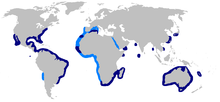Black shark
| Black shark | ||||||||||||
|---|---|---|---|---|---|---|---|---|---|---|---|---|

Black shark ( Carcharhinus obscurus ) |
||||||||||||
| Systematics | ||||||||||||
|
||||||||||||
| Scientific name | ||||||||||||
| Carcharhinus obscurus | ||||||||||||
| ( Lesueur , 1818) |
The black shark or gloomy shark ( Carcharhinus obscurus ) is a species of the genus Carcharhinus within the Requiem sharks (Carcharhinidae). The range of this species stretches along the coasts of various marine areas of the Pacific, Indian and Atlantic Oceans. It can reach a maximum length of over four meters and is classified as potentially dangerous for humans.
Appearance and characteristics
The black shark is a large and compactly built shark with an average size of 250 to 300 cm and a maximum length of over 400 cm. It has a dark to bronze-gray color without any noticeable markings, and an indistinct, light-colored flank stripe can be formed on the flanks.
The shark's snout is wide and rounded. It has an anal fin and two dorsal fins . The first dorsal fin is slightly bent, it is level with the end of the free pectoral fins. An interdorsal ridge is present. The second dorsal fin is smaller than the first. The pectoral fins are relatively large and sickle-shaped. Like all species of the genus, the animals have five gill slits and no injection hole .
Way of life
The black shark lives near the coast in the area of the continental shelf and on island bases at depths of up to 400 m. The adult animals migrate mainly in the northern areas of distribution in the Atlantic and Pacific in summer to cooler waters and in winter back to warmer areas. Young sharks form large schools.
nutrition
It predatory feeds on a wide range of different prey, especially different bony fish such as sardines , herrings , mackerels , barracudas and other types of shark ( angel sharks , dogfish and smooth sharks ). Various molluscs and crustaceans also belong to its range of foods. Black sharks also track ships and are likely to eat the garbage that accumulates on them.
The young sharks in particular are hunted by larger sharks such as the great white shark , the tiger shark or the sand tiger shark . Larger specimens have no enemies other than humans.
Reproduction
Like other species of the genus, it is viviparous and forms a yolk sac placenta ( placental viviparous ). The females give birth to 3 to 14 young animals, based on measurements of the embryos a gestation period of up to 16 months is assumed. The young sharks are around 70 to 100 centimeters in size and are born near the coast in shallow bays. The slowly growing animals reach sexual maturity only after 6 years with a length of about 280 cm.
distribution
The distribution area of the black shark stretches along the coasts of various tropical and warm-temperate sea areas of the Pacific, Indian and Atlantic Oceans. It occurs in the western Atlantic off the coast of the USA from southern Massachusetts to Florida , on the Bahamas , near Cuba and in the northern Gulf of Mexico, and along the South American coast to Brazil . In the Indian Ocean it can be found off the coast of South Africa and Madagascar , and it lives in the Red Sea , off the entire coast of Australia and off California .
In the Mediterranean , the black shark is an occasional visitor and is rarely seen. The animals immigrate via the Strait of Gibraltar or the Suez Canal . In 1978 a 2.5 meter long animal was caught in one of the canals in Venice , and in 1998 a 3 meter long shark was sighted by a diver off Martigues , France. The reproduction has not yet been proven for the Mediterranean. Black sharks have been sighted regularly off the coast of Hadera in northern Israel since 2016 .
Danger
The black shark is classified as endangered (Vulnerable) in the Red List of Endangered Species of the IUCN . The main threat comes from fishing, in which the black shark is often caught as bycatch and usually dies in the nets.
supporting documents
- ↑ de Maddalena & Bänsch 2005; Pp. 198-200
- ↑ Carcharhinus obscurus (Dusky Shark). Retrieved October 16, 2018 .
- ↑ Carcharhinus obscurus in the endangered Red List species the IUCN 2009. Posted by: Musick, JA, Grubbs, RD, Tree, J. & Cortés, E., 2009. Retrieved on October 16, 2018 ..
literature
- Leonard Compagno , Marc Dando, Sarah Fowler: Sharks of the World. Princeton Field Guides, Princeton University Press , Princeton and Oxford 2005; Pp. 302-303, ISBN 978-0-691-12072-0
- Alessandro de Maddalena, Harald Bänsch: Sharks in the Mediterranean. Franckh-Kosmos Verlags-GmbH, Stuttgart 2005, pp. 198-200, ISBN 3-440-10458-3 .
Web links
- Species portrait on hai.ch
- Black Shark on Fishbase.org (English)

